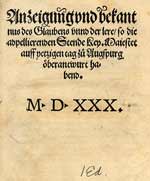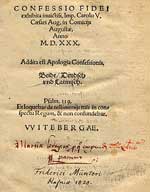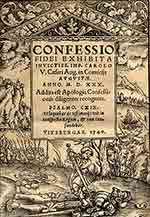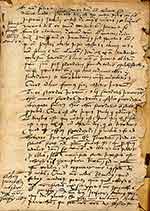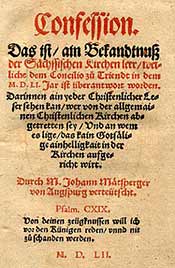The Gruber Rare Books Collection and Other Rare Books
Augsburg Confession and The Apology of the Augsburg Confession
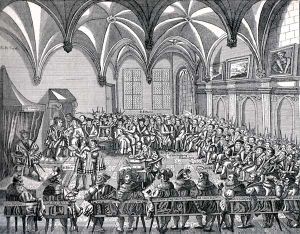
Setting for the Presentation of the Augsburg Confession, June 25, 1530.
The Lutheran governments presented their Augsburg Confession, written by Melanchthon in consultation with Luther, at the Diet of Augsburg on June 25, 1530. The emperor forbade its publication, but seven editions quickly appeared anyway, six in German and one in Latin; those texts, however, are not entirely reliable.
Gruber 162 Anzeigung und bekantnus des Glaubens unnd der lere, so die adpellierenden Stende Key. Maiestet auff...Augspurg Oberantwurt habend. This is a copy of the Augsburg Confession in German from 1530. A letter from Philipp Melanchthon addressed to J. Lang, dated to November 26, 1540, is bound with this document. This letter is discussed under Melanchthon’s Works.
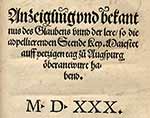
Gruber 176 Duplicate of 162, but incomplete. Ends at G4 1st edition
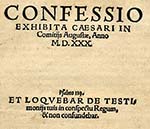
Gruber 163 Confessio Exhibita Caesari In Comitiis Augustae, Anno MDXXX. First Latin edition of Augsburg Confession. A letter of Philipp Melanchthon to Hermann Huddaeus, dated to October 3, 1559, is bound with this document. This letter is discussed under Melanchthon’s Works.
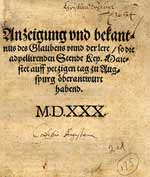
Gruber 175 Anzeigung und bekantnus des Glaubens unnd der lere, so die adpellirenden Stende Key. Maiestet auff...Augspurg öberantwurt habend. This is a copy of the second edition of the Augsburg Confession in German from 1530.
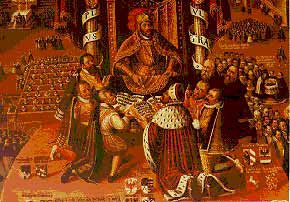
An artist's rendition of the presentation of the Augsburg Confession to Charles V, the Holy Roman Emperor.
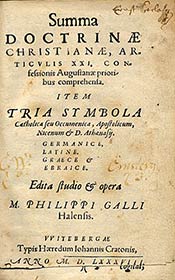
Gruber 261. Summa doctrinae Christianae, articvlis XXI, Confessionis Augustanae prioribus comprehensa. Item Tria Symbolia...Germanice, Latine, Graece & Ebraice. Edita studio & operat. Wittebergae, Haeredum Iohannis Cratonis, MDLXXXVIII 1588. By Philipp Gall, (1558-1616), also known as Philipp Hahn.
This book contains the ecumenical creeds and the first 21 Articles of the Augsburg Confession in four languages: Hebrew, Greek, Latin, and German. The Augsburg Confession had been translated into Greek by Paul Dolscius in 1558, and Philipp Melanchthon (1497-1560) had sent this translation to the Patriarch Joseph in Constantinople. Lutherans at this time hoped to establish a relationship to the Orthodox Churches. Article IV of the Augsburg Confession has been expanded in this translation. Gall used the Greek text of the Augsburg Confession published in Wittenberg in 1587, (see next photo below) which showed some mistakes in comparison with the first edition. Immanuel Tremellius (1510-1580), a Jewish convert to Christianity, and Johannes Claius (1535-1592) had translated the Apostles Creed into Hebrew, and this translation was included by Gall in this volume.
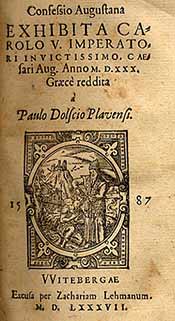
Gall dedicated his book to Johann Sigismund (1572-1619), Elector of Brandenburg. He was originally a Lutheran but became a Calvinist in 1613. In an appendix to this dedicatory letter, Gall included a letter from Johannes Olearius the Elder (1546-1623), his Superintendent in Halle, dated January 27, 1588. Olearius urged Gall to publish his translation of the Augsburg Confession to encourage young people to similar studies and to bring honor to his city of Halle. Dolscius had also lived in Halle.
This translation would help gymnasium students at Halle, where Olearius taught. Olearius believed that the Hebrew would be eagerly read by Jews since only a few of them understood Latin and they generally neglected German. Olearius noted that Rabbi Paulus Elchanan from Prague had read Matthew and Hebrews in Hebrew and had converted to Christianity. Olearius believed that only the idolatry and heresies of the papacy kept more Jews from coming to the faith.
Gall translated the twenty-one articles of the Augsburg Confession into Hebrew at first only to deepen his theological and linguistic knowledge. He believed that Hebrew was the mother of all languages. He depended on biblical vocabulary and syntax wherever possible, but for words like "persona," original sin, or free will he used rabbinic concepts or paraphrases.
Gall translated the original version of the Augsburg Confession, from a reprint of 1585,
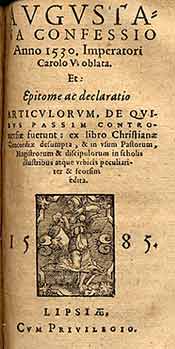
not the Variata, as can be seen in this copy of Article X.
With this is bound: Confessio Augustana Exhibita Carlo V...Graece reddita a paulo Dolscio Plavensi. Wittebergae: Zachariam Lehmanum, 1587; Augusta Confessio Anno 1530...et Epitome ac declaratio...1585; Augustana Confessio Anno 1530...et: epitome ac declaratio...Lipsiae, Cum privilegio, 1585. The colophon reads: Excudebat Georgius Defner. Anno M. D. LXXXV. This volume also contains the Epitome of the Formula of Concord in Latin.
 Gruber 43 Confessio odder Bekantnus des Glaubens etlicher Fürsten und Stedte. Uberantwort Keiserlicher
Maiestat zu Augspurg. Anno MDXXX. This is the German version of the Augsburg Confession, and a German translation of the Apology of the Augsburg Confession made by Justus Jonas (1493-1555).
Gruber 43 Confessio odder Bekantnus des Glaubens etlicher Fürsten und Stedte. Uberantwort Keiserlicher
Maiestat zu Augspurg. Anno MDXXX. This is the German version of the Augsburg Confession, and a German translation of the Apology of the Augsburg Confession made by Justus Jonas (1493-1555).
 Gruber 62 Another copy of 43. A late note inserted in the book
suggests that this may have been Luther's personal copy. Very likely first edition.
The first edition of the Augsburg Confession and the Apology in German appeared in the fall of 1531, delayed by the task of translating the Apology out of the Latin. All subsequent editions have borne on their title-page the motto: "I spoke of your testimonies before kings, and was not put to shame."
Gruber 62 Another copy of 43. A late note inserted in the book
suggests that this may have been Luther's personal copy. Very likely first edition.
The first edition of the Augsburg Confession and the Apology in German appeared in the fall of 1531, delayed by the task of translating the Apology out of the Latin. All subsequent editions have borne on their title-page the motto: "I spoke of your testimonies before kings, and was not put to shame."
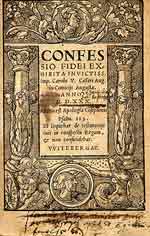 Gruber 46 Confessio Fidei Exhibita Invictiss. Imp. Carolo V Caesari Aug. in Comiciis Augustae. Anno MDXXX. Addita est Apologia Confessionis. Psalm 119. Witebergae: Georgium Rhau. MDXXXI. The first Latin edition of the Augsburg Confession and the Apology of the Augsburg Confession, according to a note on the inside front cover.
Gruber 46 Confessio Fidei Exhibita Invictiss. Imp. Carolo V Caesari Aug. in Comiciis Augustae. Anno MDXXX. Addita est Apologia Confessionis. Psalm 119. Witebergae: Georgium Rhau. MDXXXI. The first Latin edition of the Augsburg Confession and the Apology of the Augsburg Confession, according to a note on the inside front cover.
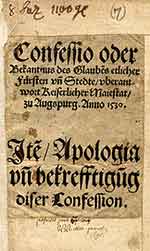
Gruber 7 Confessio oder Bekantnus des Glaubens etlicher fürsten un Stedte uberantwort Keiserlicher Maiestat zu Augspurg Anno 1530. The Augsburg Confession and the Apology of the Augsburg Confession in German. Justus Jonas translated the Apology from Latin to German. Dated by its colophon to November 1531.
Gruber 14 Confessio Fidei exhibita invictiss. Imp. Carolo V Caesari Aug. in Comiciis Augustae. Anno MDXXX. Addita est Apologia Confessionis. Both the Augsburg Confession and the Apology are given in Latin first and then in German. The Latin quotation on the title page is from Psalm 119:46: "I will also speak of your decrees before kings, and shall not be put to shame."
Gruber 26. Under Melanchthon's supervision the official Latin text of the confession was printed together with his newly composed Apology in the spring of 1531. In the preface Melanchthon wrote: It is important to make public the authentic text, since an unreliable version has been published by a greedy printer two months ago. While the title page indicates that the two confessions are given in German and Latin, this volume only contains the first edition of the Latin.
Gruber 13 The confessyon of the fayth of the Germaynes exhibited to the most victorious Emperor Charles the V in the councell of assemblee holden at Augusta the yere of our lorde 1530. The scan on the left is for the title page of the Apology of the Augsburg Confession. London: Robert Redman, 1536. A translation of the Augsburg Confession and the Apology into English by Richard Taverner by the command of Thomas Cromwell (1485-1540). Cromwell planned and executed the political maneuvers that gave the Church of England independence from Rome. He supported Henry VIII's marriage to Anne Boleyn, but was later beheaded. This translation was printed with the permission of King Henry VIII. The Gruber collection also contains a facsimile of this translation, edited by Henry E. Jacobs and published in Philadelphia in 1888.
Gruber 28 Confessio Fidei Exhibita Invictiss. Imp. Carolo V. Caesari Augs. in Comiciis Augustae Anno MDXXX. Addita est Apologia Confessionis diligenter recognita.Vitebergae: Georgium Rhau MDXL (1540). This is a Latin copy of the Augsburg Confession and the Apology of the Augsburg Confession. They are bound with a copy of Philipp Melanchthon's Loci Communes of 1541. This version of the Augsburg Confession is the so-called Variata, in which Melanchthon made a number of changes in an attempt to compromise with the Calvinists. In Article 10 dealing with the Lord's Supper, the original text read: "Our churches teach that the body and blood of Christ are truly present and are distributed to those who eat in the Supper of the Lord. They disapprove of those who teach otherwise." The Variata reads: "Our churches teach that with bread and wine are truly exhibited the body and blood of Christ to those that eat in the Lord's Supper."
A copy of Article X in the Variata edition.
The last two pages of Gruber 28 contain annotations in Luther's own handwriting. Click to enlarge thumbnails.
This is a copy of the Augsburg Confession and the Apology from 1540, but the Augsburg Confession is not the Variata edition. This volume is from the library of Nils Forsander (1846-1926), a professor at Augustana Seminary.
This is a confession of faith of the churches in Saxony that was submitted in the Council of Trent (1545-1563) in 1552.
The Gruber Collection was assembled by L. Franklin Gruber, President of Chicago Lutheran Theological Seminary, Maywood, Illinois.
Annotation prepared by Ralph W Klein
